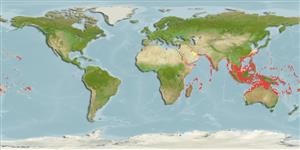>
Carangiformes (Jacks) >
Carangidae (Jacks and pompanos) > Scomberoidinae
Etymology: Scomberoides: Greek, skombros = tunny or mackerel, 1623 + Greek, oides = similar to (Ref. 45335).
Environment: milieu / climate zone / profondeur / distribution range
Écologie
marin; saumâtre récifal; profondeur 0 - 100 m (Ref. 3197). Tropical; 26°C - 29°C (Ref. 4959); 30°N - 31°S, 18°E - 143°W
Indo-Pacific: Red Sea and East Africa to Hawaii, Marquesas, Line and Tuamoto islands, north to southern Japan, south to New South Wales and Rapa.
Taille / Poids / Âge
Maturité: Lm ? range ? - ? cm
Max length : 110 cm TL mâle / non sexé; (Ref. 4225); common length : 60.0 cm TL mâle / non sexé; (Ref. 9987); poids max. publié: 11.0 kg (Ref. 9987)
Épines dorsales (Total) : 7 - 8; Rayons mous dorsaux (Total) : 19 - 21; Épines anales: 3; Rayons mous anaux: 17 - 19.
Body shape (shape guide): fusiform / normal; Cross section: compressed.
Found only in relatively clear waters (Ref. 32693), adults in clear lagoon and seaward reefs, juveniles in shallow inshore and brackish waters (Ref. 9710). Pelagic (Ref. 58302). Mainly solitary but sometimes form small loose groups (Ref. 48635). Adults feed on small fishes and crustaceans (Ref. 5213) while juveniles feed on scales and epidermal tissues torn from other schooling fishes (Ref. 9710, 90102). Venom glands were not visible, not able to be confirmed in specimen (Ref. 57406). Utilized fresh, dried or salted or frozen (Ref. 9987).
Life cycle and mating behavior
Maturité | Reproduction | Frai | Œufs | Fécondité | Larves
Migrate to the outer reef slope to spawn several days after the full moon (Ref. 37816).
Paxton, J.R., D.F. Hoese, G.R. Allen and J.E. Hanley, 1989. Pisces. Petromyzontidae to Carangidae. Zoological Catalogue of Australia, Vol. 7. Australian Government Publishing Service, Canberra, 665 p. (Ref. 7300)
Statut dans la liste rouge de l'IUCN (Ref. 130435: Version 2025-1)
Utilisations par l'homme
Pêcheries: intérêt commercial mineur; pêche sportive: oui; appât: occasionally
Outils
Articles particuliers
Télécharger en XML
Sources Internet
Estimates based on models
Preferred temperature (Réf.
123201): 25.2 - 29, mean 28 °C (based on 1708 cells).
Phylogenetic diversity index (Réf.
82804): PD
50 = 0.5625 [Uniqueness, from 0.5 = low to 2.0 = high].
Bayesian length-weight: a=0.00955 (0.00757 - 0.01205), b=2.92 (2.86 - 2.98), in cm total length, based on LWR estimates for this species (Ref.
93245).
Niveau trophique (Réf.
69278): 4.0 ±0.67 se; based on food items.
Generation time: 3.3 ( na - na) years. Estimated as median ln(3)/K based on 1
growth studies.
Résilience (Réf.
120179): Milieu, temps minimum de doublement de population : 1,4 à 4,4 années (Preliminary K or Fecundity.).
Prior r = 0.61, 95% CL = 0.40 - 0.91, Based on 2 data-limited stock assessments.
Fishing Vulnerability (Ref.
59153): Moderate vulnerability (40 of 100).
🛈
Climate Vulnerability (Ref.
125649): Very high vulnerability (88 of 100).
🛈
Nutrients (Ref.
124155): Calcium = 34.6 [19.1, 65.3] mg/100g; Iron = 0.738 [0.424, 1.301] mg/100g; Protein = 20.1 [19.1, 21.2] %; Omega3 = 0.154 [0.104, 0.251] g/100g; Selenium = 44.5 [26.4, 78.3] μg/100g; VitaminA = 49.4 [15.4, 149.4] μg/100g; Zinc = 0.82 [0.58, 1.12] mg/100g (wet weight);
